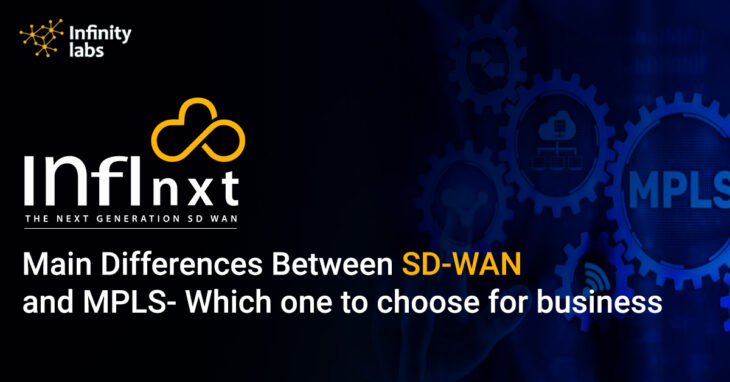
When any enterprise expands, they need to have a network infrastructure that can connect its different branches and remote offices. So, there’s great pressure on the IT department of the enterprises to manage the enterprise’s performance, reliability, and security while keeping compliance as well as cost in mind. When it comes to connecting networks over a large distance, some complexities can arise related to increased cost and reduced performance. This makes the selection of WAN architecture to connect remote sites challenging. Well, there are two crucial options of WAN that businesses can go for namely SD-WAN technology and MPLS.
So, which technology is the best option for enterprises to connect multiple locations? Which solution- SD-WAN or MPLS can help in managing performance, reliability, security, and cost? Before understanding which WAN architecture is better, we must know about each of the discreetly.
Knowing what is SD-WAN Technology
Software-Defined Wide Area Networks (SD-WAN) is a software-based solution that has been adopted and implemented by most enterprises. This is a newer approach to WAN that helps in separating the network control from data forwarding plane. In simple words, software-defined WAN is a large network that connects LANs through software, not hardware. Along with this, SD-WAN makes the network available using the software so that deployment and configuration can be achieved easily.
When a company uses SD-WANs, there won’t be any issue of geographic boundaries. The company’s long-distance networking needs will be solved with this solution. As it is a software based technology, you can manage the entire network centrally with the software itself. On top of that, SD-WAN offers built-in security which means your network traffic is fully encrypted.
SD-WAN solution benefits organizations that are looking for reliability and flexibility to connect remote networks. Even if there are different types of connections, the SD-WAN network will manage them with ease.
What is MPLS Technology
MPLS stands for Multiprotocol label switching which is a WAN architecture that is needed for constructing the connections between local area networks to make up wide area networks. In simple words, MPLS is a private connection that is used to link data centers, remote locations, and different branch offices. MPLS usually sends packets through predetermined network paths with the help of specialized routers.
Also called as predetermined network paths, these MPLSs can be used as the connective network that involves a WAN. It also allows multiple virtual WANs to synchronize over the same shared network.
It can be said that MPLS is a hardware-based networking technology in which labels are used instead of addresses to find the shortest possible route for data routing. MPLS is surely not a modern technology for a network but it shows efficiency. With this technology, one can get consistent connectivity and negligible loss of data.
Crucial consideration that needs to be kept in mind is that the SD-WAN model includes different usages of MPLS. So, MPLS is one of the networking methods that can be seen using SD-WAN. However, in comparison, SD-WANs are considered a more reliable, secure, and cost-effective approach.
SD-WAN offers higher protection and performance than MPLS
With MPLS, you get secured and managed links between the data center and branch offices via the service provider’s internal network. But, MPLS technology does not offer any analysis of the data that it delivers. While traversing an MPLS connection, it is crucial to check the traffic for malware or other threats. Because of this, there is a need for the deployment of a network firewall and other additional security functions at one end of the connection.
But, this is not the case with the SD-WAN solution. From a security perspective, the SD-WAN solution is a reliable and secure WAN technology that also ensures better performance. With this new WAN, businesses get a layer of flexible connectivity options ideal for remote offices that MPLS cannot do.
Benefits of SD-WAN over MPLS
Though both SD-WAN and MPLS are WAN architecture, there are still some pointers or benefits that give an upper hand to the SD-WAN network. Let’s check them out discreetly:
Easy integration with the cloud
Businesses that are using SD-WANs can easily integrate with the cloud. Unfortunately, connecting to the cloud through MPLS requires expert help as it is a specialized service. If a business is using MPLS, connection with the cloud requires the construction of a direct route to the provider’s infrastructure.
Offers more Flexibility
One thing to keep in mind is that SD-WAN routing is more flexible than MPLSs. It also allows multiple connectivity options and can direct traffic between all available connectivity options in case of failure in one connection. But, this is not possible with MPLS services as they require dedicated private line connections.
No Bandwidth Limits
With SD-WAN, there is no issue of bandwidth limitation. MPLS connections have limitations related to capacity that can be provisioned through the connection at once. In the case of SD-WAN connections, one can keep adding the capacity as required by multiple connections.
To sum up
There are numerous benefits to using both SD-WAN and MPLS technology. Compared to MPLS, SD-WAN is considered to be a more efficient, secure, and cost-effective solution. SD-WAN technology also provides higher performance and reduces network complexities. However, MPLS can cost you higher for bandwidth and it doesn’t protect your network from vulnerabilities.